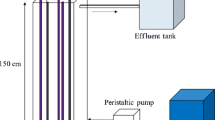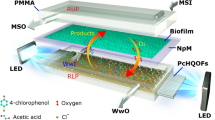Abstract
An integrated photocatalytic-biological reactor (IPBR) was developed for accelerated phenol degradation and mineralization. In the IPBR, photodegradation and biodegradation occurred simultaneously, but in two separated zones: a piece of mat-glass plate coated with TiO2 film and illuminated by UV light was connected by internal circulation to a honeycomb ceramic that was the biofilm carrier for biodegradation. This arrangement was designed to give intimate coupling of photocatalysis and biodegradation. Phenol degradation was investigated by following three protocols: photocatlysis with TiO2 film under ultraviolet light, but no biofilm (photodegradation); biofilm biodegradation with no UV light (biodegradation); and simultaneous photodegradation and biodegradation (intimately coupled photobiodegradation). Photodegradation alone could partly degrade phenol, but was not able to achieve significant mineralization, even with an HRT of 10 h. Biodegradation alone could completely degrade phenol, but it did not mineralize the COD by more than 74%. Photobiodegradation allowed continuous rapid degradation of phenol, but it also led to more complete mineralization of phenol (up to 92%) than the other protocols. The results demonstrate that intimate coupling was achieved by protecting the biofilm from UV and free-radical inhibition. With phenol as the target compound, the main advantage of intimate coupling in the IPBR was increased mineralization, presumably because photocatalysis made soluble microbial products more rapidly biodegradable.









Similar content being viewed by others
References
Alinsafi A, Evenou F, Abdulkarim EM, Pons MN, Zahraa O, Benhammou A, Yaacoubi A, Nejmeddine A (2007) Treatment of textile industry wastewater by supported photocatalysis. Dyes Pigm 74:439–445
Bai J, Wen JP, Li HM, Jiang Y (2007) Kinetic modeling of growth and biodegradation of phenol and m-cresol using Alcaligenes faecalis. Process Biochem 42:510–517
Balcioglu IA, Arslan I (1998) Application of photocatalytic oxidation treatment to pretreated and raw effluents from the kraft bleaching process and textile industry. Environ Pollut 103(2–3):261–268
Balcioglu IA, Cecen F (1999) Treatability of kraft pulp bleaching wastewater by biochemical and photocatalytic oxidation. Water Sci Technol 40:281–288
Calderia M, Heald SC, Carvalho MF, Vasconcels I, Bull AT, Castro PML (1999) 4–Cholorophenol degradation by a bacterial consortium: development of a granular activated carbon biofilm reactor. Appl Microbiol Biotechnol 52:722–729
Fang HHP, Zhou GM (1997) Denitrification of phenolics wastewater by immobilized sludge. Environ Technol 18:827–834
Feng W, Wen J, Liu C, Yuan Q, Jia X, Sun Y (2007) Modeling of local dynamic behavior of phenol degradation in an internal loop airlift bioreactor by yeast candida tropicalis. Biotechnol Bioeng 97:251–264
Godjevargova T, Aleksieva Z, Ivanova D, Shivarowa N (1998) (1998) Biodegradation of phenol by Trichosporon cutaneum cells covalently bound to polyamide granules. Process Biochem 13:831–835
Ho K, Lin B, Chen Y, Lee D (2009) Biodegradation of phenol using Corynebacterium sp. DJ1 aerobic granules. Bioresour Technol 100:5051–5055
Houlb W, Przytocka-Jusiak M, Blaszczyk R (2000) Nitrate as agent selecting anaerobic phenol-degrading microflora in petroleum refining sediments. Water Res 34:1354–1358
Hu C, Wang Y (1999) Decolorization and biodegradability of photocatalytic treated azo dyes and wool textile wastewater. Chemosphere 39(12):2107–2115
Huang G, Yang Y, Zhang L, Liu Y (2009) Effect of Hydraulic Retention Time on the Formation of Soluble Microbial Products in Aerobic Completely Stirred Tank Reactor. Journal of East China University of Science and Technology (Natural Science Edition) 35(1):66–70
Jianmin W, Gowei G, Chonghua Z (1993) Anaerobic biodegradation of phenol:bacterial accumulation and system performance. Water Sci Technol 28:17–22
Juang RS, Tsai SY (2006) Growth kinetics of Pseudomonas putida in the biodegradation of single and mixed phenol and sodium salicylate. Biochem Eng J 31:133–140
L'Amour RJA, Azevedo EB, Leite SGF, Dezotti M (2008) Removal of phenol in high salinity media by a hybrid process (activated sludge+photocatalysis). Separ Purif Tech 60:142–146
Laspidou CS, Rittmann BE (2002) Non-steady-state modeling of microbial products and active and inert biomass. Water Res 36:1983–1992
Li XZ, Zhao YG (1999) Advanced treatment of dyeing wastewater for reuse. Water Sci Technol 39(10–11):249–255
Mallak M, Bockmeyer M, Löbmann P (2007) Liquid phase deposition of TiO2 on glass: systematic comparison to films prepared by sol–gel processing. Thin Solid Films 515:8072–8077
Marsolek MD, Torres CI, Hausner M, Rittmann EB (2008) Intimate coupling of photocatalysis and biodegradation in a photocatalytic circulating-bed biofilm reactor. Biotechnol Bioeng 101:83–92
Mohanty S, Rao NN, Khare P, Kaul SN (2005) A coupled photocatalytic-biological process for degradation of 1-amino-8-naphthol-3, 6-disulfonic acid (H-acid). Water Res 39(20):5064–5070
Namkung E, Rittmann BE (1986) Soluble microbial products (SMP) formation kinetics by biofilms. Water Res 20(6):795–806
Nuhoglu N, Yalcin B (2005) Modeling of phenol removal in a batch reactor. Process Biochem 40:1233–1239
Pawlowsky U, Howell JA (1973) Mixed culture biooxidation of phenol. I. Determination of kinetic parameters. Biotechnol Bioeng 15:889–896
Reddy MP, Srinivas B, Kumari VD, Subrahmanyam M, Sharma PN (2004) An integrated approach of solar photocatalytic and biological treatment of N-containing organic compounds in wastewater. Toxicol Environ Chem 86(1–4):125–138
Sarfraz S, Thomas S, Tewari UK, Iyengar L (2004) Anoxic treatment of phenolics wastewaters in sequencing batch reactor. Water Res 38:965–971
Wei F (2002) Monitoring and analytic methods of water and wastewater, 4th edn. Environmental Science Press of China, Beijing
Yan J, Jianping W, Bai J, Daoquan W, Zongding H (2006) Phenol biodegradation by the yeast Candida tropicalis in the presence of m-cresol. Biochem Eng J 29:227–23
Yang RD, Humphrey AE (1975) Dynamic and steady state studies of phenol biodegradation in pure and mixed cultures. Biotechnol Bioeng 17:1211–1235
Yuan L, Jiang L, Peng Z, Ruan Q (2009) Breeding of the high phenol-degraded bacterium JY01 and study on phenolic biodegradation. Microbiology Bulletin 36:587–592
Zhang Y, Han L, Wang J, Yu J, Shi H, Qian Y (2002) An internal airlift loop bioreactor with Burkholderia pickttii immobilized onto ceramic honeycomb support for degradation of quinoline. Biochem Eng J 11(2–3):149–157
Zhang Y, Quan X, Rittmann BE, Wang J, Shi H, Qian Y, Yu J (2004) IAL-CHS (internal airlift loop—ceramic honeycomb supports) reactor used for biodegradation of 2, 4-dichlorophenol and phenol. Water Sci Technol 49(11–12):247–254
Zhang X, Huang W, Wang X, Gao Y, Lin H (2009) Feasibility and advantage of biofilm-electrode reactor for phenol degradation. J Environ Sci 21:1181–1185
Acknowledgements
The authors acknowledge the financial support by the National Natural Science Foundation of China (50678102), the Special Foundation of Chinese Colleges and Universities Doctoral Discipline (20070270003), the Shanghai Leading Academic Discipline Project (S30406), the Leading Academic Discipline Project of Shanghai Normal University (DZL711), and the US National Science Foundation (0651794). Precious Biyela provided valuable comments on the manuscript.
Author information
Authors and Affiliations
Corresponding author
Rights and permissions
About this article
Cite this article
Zhang, Y., Wang, L. & Rittmann, B.E. Integrated photocatalytic-biological reactor for accelerated phenol mineralization. Appl Microbiol Biotechnol 86, 1977–1985 (2010). https://doi.org/10.1007/s00253-010-2458-x
Received:
Revised:
Accepted:
Published:
Issue Date:
DOI: https://doi.org/10.1007/s00253-010-2458-x




